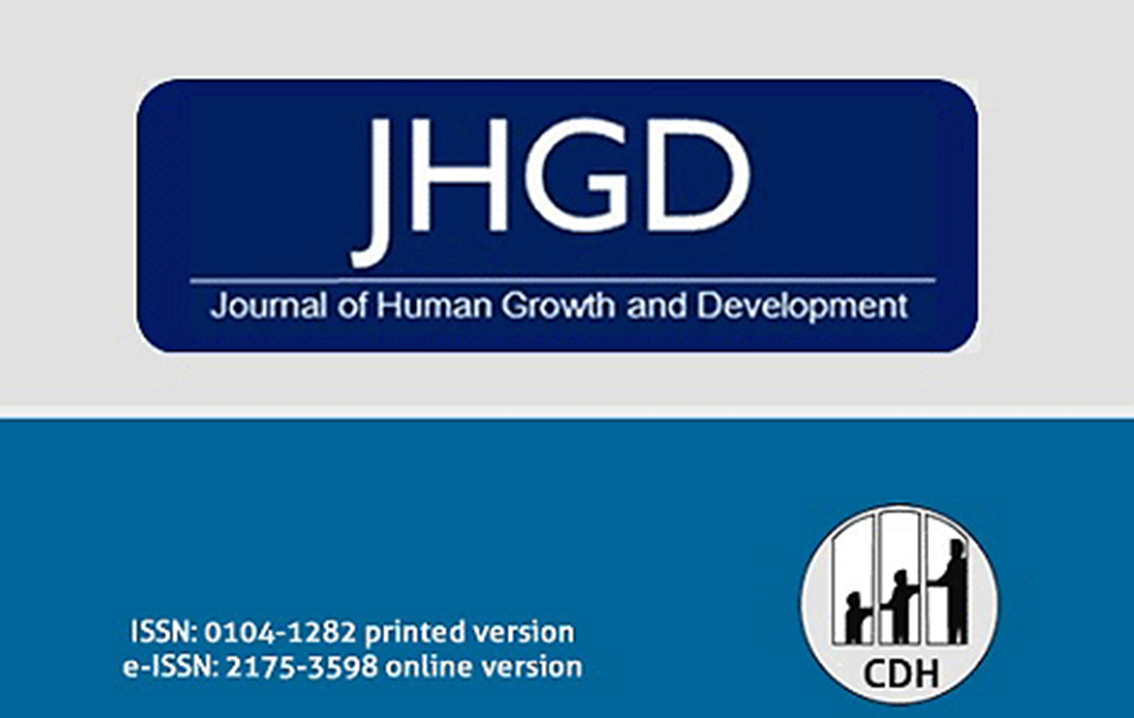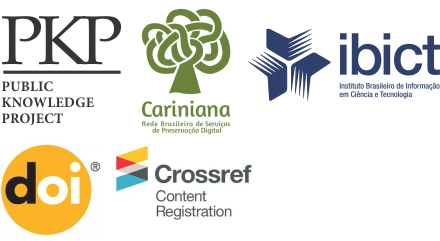Level of physical activity and motor coordination of schoolchildren in different maturational stages
DOI:
https://doi.org/10.7322/jhgd.v29.9536Keywords:
Motor activity, Motor skills, Sexual DevelopmentAbstract
Introduction: Motor development studies and debates reveal that sport and physical activity develop and improve motor skills. These studies seek to understand the changes that occur with movement, which becomes more complex as it develops through physical activity.
Objective: To compare the level of physical activity and motor coordination of students in different maturational stages and to relate the level of physical activity with the motor coordination of young people.
Methods: Descriptive research with cross-sectional design. A total of 46 male subjects aged 10 to 14 years participated in the study. Baecke's usual physical activity questionnaire was applied; the maturity stage was verified through the Puberal Maturation Prediction Equation; the body composition was evaluated through the Guedes protocol for children and adolescents; Finally, the coordinative performance was classified using the Korperkoordinationstest fur Kinder (KTK) test battery.
Results: There were significant differences for the variables Age and Height among all stages: P3, P4 and P5 maturation. The differences found in the variable body weight occurred only between the P3 and P5 stages; P4 and P5. It was also observed that no significant differences were found for motor coordination between maturation stages. The same occurred when physical activity indexes were compared.
Conclusion: There is no difference in the level of physical activity between stages 3, 4 and 5 of sexual maturation, nor does the maturational stage seem to influence the level of motor coordination of young students.
Downloads
References
2. Matsudo SM, Matsudo VR, Araújo T, Andrade D, Andrade E, Oliveira L, et al. Nível de atividade física da população do Estado de São Paulo: análise de acordo com o gênero, idade, nível socioeconômico, distribuição geográfica e de conhecimento. Rev Bras Ciên Mov. 2002; 10(4):41-50. DOI: http://dx.doi.org/10.18511/rbcm.v10i4.469
3. Silva DK, Nahas MV. Prescrição de exercícios físicos para pessoas com doença vascular periférica. Rev Bras Ciên e Mov. 2002;10(1):55-61.
4. Moraes H, Deslandes A, Ferreira C, Pompeu FAMS, Ribeiro P, Laks J. O exercício físico no tratamento da depressão em idosos: revisão sistemática. Rev Psiquiatr Rio Gd. Sul. 2007; 29(1):70-9. DOI: https://doi.org/10.1590/S0101-81082007000100014
5. Kim SE, Kim JW, Jee YS. Relationship between smartphone addiction and physical activity in Chinese international students in Korea. J Behav Addict. 2015;4(3):200-5. DOI: https://doi.org/10.1556/2006.4.2015.028
6. Mielgo-Ayuso J, Aparicio-Ugarriza R, Castillo A, Ruiz E, Avila JM, Aranceta-Bartrina J, et al. Sedentary behavior among Spanish childreen and adolescentes: findings from the ANIBES study. BMC Public Health. 2017;17:94. DOI: https://doi.org/10.1186/s12889-017-4026-0
7. Keane E, Li X, Harrington JM, Fitzgerald AP, Perry IJ, Kearney PM. Physical activity, sedentary behavior and the risk of overweight and obesity in school-aged children. Pediatr Exerc Sci. 2017;29(3):408-18. DOI: https://doi.org/10.1123/pes.2016-0234
8. Wu XY, Han LH, Zhang JH, Luo S, Hu JW, Sun K. The influence of physical activity, sedentary behavior on health-related quality of life among the general population of children and adolescents: A systematic review. PloS One. 2017;12(11):e0187668. DOI: https://doi.org/10.1371/journal.pone.0187668
9. Boreham C, Riddoch C. The physical activity, fitness and health of children. J Sports Sci. 2001;19(12):915-29. DOI: https://dx.doi.org/10.1080/026404101317108426
10. Zahner L, Dossegger A. Motor activity-the key to development in childhood. In: Dossegger L. Active Childhood-Healthy Life. Basle: FOSPO; Institute for Exercise and Health Sciences, University of Basle; Winterthur: 2004; p. 41-86.
11. Welk GJ. The youth physical activity promotion model: a conceptual bridge between theory and practice. Quest. 1999;51(1):5-23. DOI: https://doi.org/10.1080/00336297.1999.10484297
12. Gallahue D, Ozmun J, Goodway J. Compreendendo o desenvolvimento motor. 7th ed. Porto Alegre: AMGH; 2013; p. 20-41.
13. Cabral BG, Cabral SA, Medeiros RM, Alcatara T, Dantas PMS. Relação da maturação com a antropometria e aptidão física na iniciação desportiva. Motricidade. 2013;9(4):12-21. DOI: http://dx.doi.org/10.6063/motricidade.9(4).689
14. Lee EY, An K, Jeon JY, Rodgers WM, Harber VJ, Spence JC. Biological Maturation and Physical Activity in South Korean Adolescent Girls. Med Sci Sports Exerc. 2016;48(12): 2454-61. DOI: http://dx.doi.org/10.1249/MSS.0000000000001031
15. Siervogel R, Maynard LM, Wisemandle WA, Roche AF, Guo SS, Chumlea WC, et al. Annual changes in total body fat and fat-free mass in children from 8 to 18 years in relation to changes in body mass index. The Fels Longitudinal Study. Ann N Y Acad Sci. 2000; 904: 420-3. DOI: https://doi.org/10.1111/j.1749-6632.2000.tb06494.x
16. Zangirolami-Raimundo J, Echeimberg JO, Leone C. Research methodology topics: Cross-sectional studies. Journal of Human Growth and Development. 2018;28(3):356-60. DOI: http://dx.doi.org/10.7322/jhgd.152198
17. Baecke JA, Burema J, Frijters JE. A short questionnaire for the measurement of habitual physical activity in epidemiological studies. Am J Clin Nutr. 1982;36(5):936-42. DOI: https://doi.org/10.1093/ajcn/36.5.936
18. Stewart A, Marfell-Jones M, Olds T, Ridder A. International standards for anthropometric assessment. New Zealand: International Society for the Advancement of Kinanthropometry, 2011.
19. Medeiros RM, Arrais RF, Azevedo JC, Andrade RD, Pinto VC, Ronque ER, et al. Predicton of pubertal maturation from anthropometric variables: proposal for a non-invasive method. J Sports Med Phys Fitness. 2018;58(5):638-43. DOI: https://doi.org/10.23736/S0022-4707.17.06564-1
20. Guedes DP, Guedes JE. Crescimento, composição corporal e desempenho motor em crianças e adolescentes. 2ª ed. São Paulo: CLR Balieiro, 2002; p. 50-65.
21. Schilling F, Kiphard EJ. Korpcrkoordinationstest für kinder, KTK. Weinheim: Beltz Test Gmbli, 1974.
22. Gorla J, Araújo P, Rodrigues J. Avaliação motora em educação física adaptada: teste KTK. 3th ed. São Paulo: Phorte; 2014; p. 139-68.
23. Barbosa KBF, Franceschini SCC, Priore SE. Influence of the stages of sexual maturation in the nutritional status, anthropometrics and corporal composition of adolescents. Rev Bras Saúde Mater Infant. 2006;6(4):375-82. DOI: http://dx.doi.org/10.1590/S1519-38292006000400003
24. Cole TJ, Ahmed ML, Preece MA, Hindmarsh P, Dunger DB. The relationship between Insulin-like Growth Factor 1, sex steroids and timing of the pubertal growth spurt. Clin Endocrinol. 2015;82(6):862-9. DOI: https://doi.org/10.1111/cen.12682
25. Surís J, Parrera N. Don’t stop, don’t stop: physical activity and adolescence. Int J Adolesc Med Health. 2005;17(1):67-80. DOI: https://doi.org/10.1515/IJAMH.2005.17.1.67
26. Seabra AF, Mendonça DM, Thomis MA, Anjos LA, Maia JA. Determinantes biológicos e sócio-culturais associados à prática de atividade física de adolescentes. Cad Saúde Pública. 2008;24(4):721-36. DOI: https://doi.org/10.1590/S0102-311X2008000400002
27. Betti M, Zuliani LR. Educação Física Escolar: uma proposta de diretrizes pedagógicas. Rev Mackenzie Educ Fís Esporte. 2002;1(1):73-81.
28. Galvão Z. Educação física escolar: a prática do bom professor. Rev Mackenzie Educ Fís Esporte. 2002;1(1):65-72.
29. Pereira ES, Moreira OC. Importância da aptidão física relacionada à saúde e aptidão motora em crianças e adolescentes. Rev Bras Prescr Fisiol Exerc. 2013;7(39):309-16.
30. Lexell J, Sjostrom M, Nordlund AS, Taylor C. Growth and development of human muscle: a quantitative morphological study of whole vastus lateralis from childhood to adult age. Muscle Nerve. 1992;15(3):404-9. DOI: https://doi.org/10.1002/mus.880150323
31. Kaczor J, Ziolkowski W, Popinigis J, Tarnopolsky, M. Anaerobic and aerobic enzyme activities in human skeletal muscle from children and adults. Pediatr Res. 2005;57(3):331-5. DOI: https://doi.org/10.1203/01.PDR.0000150799.77094.DE
32. Pinto VC, Santos PG, Dantas MP, Araújo JP, Cabral AS, Cabral BG. Relationship between skeletal age, hormonal markers and physical capacity in adolescents. J Hum Growth Dev. 2017;27(1):77-83. DOI: http://dx.doi.org/10.7322/jhgd.127658
33. Pinto VC, Santos PG, Medeiros RC, Souza FE, Simões TB, Dantas RP, et al. Maturational stages: comparison of growth and physical capacity indicators in adolescents. J Hum Growth Dev. 2018;28(1):42-9. DOI: http://dx.doi.org/10.7322/jhgd.127411
34. Dantas MP, Silva LF, Gantois P, Silva LM, Dantas RN, Cabral BT. Relação entre maturação e força explosiva em remadores jovens. Motricidade. 2018;14(S1):4-11.
35. Freitas DL, Lausen B, Maia JA, Lefevre J, Gouveia ER, Thomis M, et al. Skeletal maturation, fundamental motor skills and motor coordination in children 7-10 years. J Sports Sci. 2015;33(9):924-34. DOI: https://doi.org/10.1080/02640414.2014.977935
36. Luz LG, Seabra A, Padez C, Duarte JP, Gonçalves RR, Santos JV, et al. Perímetro da cintura como mediador da influência da maturação biológica no desempenho de coordenação motora em crianças. Revista Paulista de Pediatria. 2016; 34 (3): 352-358. DOI: https://doi.org/10.1016/j.rpped.2016.01.002
37. Deus RKBC, Bustamante A, Lopes VP, Seabra AT, Silva RMG, Maia JAR. Modelação longitudinal dos níveis de coordenação motora de crianças dos seis aos 10 anos de idade da Região Autônoma dos Açores, Portugal. Rev Bras Educ Fis Esp. 2010;24(2):259-73. DOI: https://doi.org/10.1590/S1807-55092010000200009
38. Collet C, Folle A, Pelozin F, Botti M, Nascimento JV. Motor coordination level of students from State Secretary from Florianópolis City. Motriz. 2008;14(4):373-80. DOI: https://doi.org/10.5016/2066
39. O'Brien-Smith J, Tribolet R, Smith MR, Bennett KJM, Fransen J, Pion J, et al. The use of the Körperkoordinationstest für Kinder in the talent pathway in youth athletes: A systematic review. J Sci Med Sport. 2019;22(9):1021-9. DOI: https://doi.org/10.1016/j.jsams.2019.05.014







